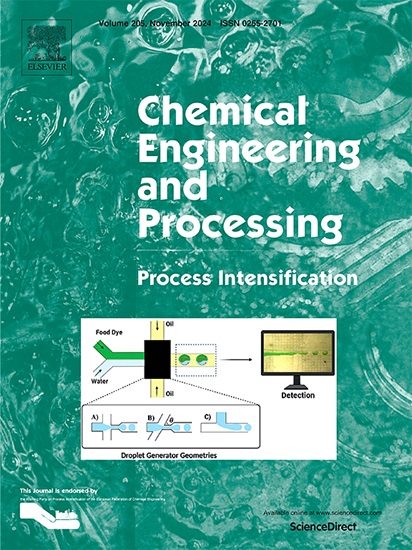Review of insertion scenarios in enhancement performance of double-pipe heat exchanger: Case of cut twist tape
IF 3.8
3区 工程技术
Q3 ENERGY & FUELS
Chemical Engineering and Processing - Process Intensification
Pub Date : 2025-04-08
DOI:10.1016/j.cep.2025.110308
引用次数: 0
Abstract
Double-Pipe Heat Exchanger (DPHX) is used in a wide range of applications including heating and cooling, chemical and food industries as well as a wide range of fields where heat transfer is necessary. This diversity of uses has made it a subject of wide interest to scholars and developers to enhance its performance. Due to ease of application and efficient, the insertion method is considered one of the important passive methods in enhancing the thermal performance of DPHX. This review is the first of its kind to survey and analyze studies that have enhanced DPHX thermal performance using cut Twist Tape (TT) inserts into the inner pipe. Several impact parameters were considered, most notably Twist Ratio (TR), Depth Ratio (DR), and Width Ratio (WR), as well as several performance parameters, most notably the Nusselt number (Nu), friction factor (f), and Thermal Performance Factor (TPF). The review results indicate that the thermal performance of DPHX is enhanced at the inserted of cut TT regardless of the difference of the cut geometries, especially with decrease TR and DR and increase WR, but with negative impact on hydraulic performance, which requires consideration of TPF and a wide range of Reynolds number (Re). Finally, most studies have shown that cut TT is superior in thermal performance enhancement over plain TT, and this enhancement can be increased when adding other techniques such as the use of nanofluid as heat transfer fluid. This review also provides recommendations that will document the gaps of the cut TT in order to future address.

提高双管换热器性能的插入方案综述:以剪切扭带为例
双管换热器(DPHX)应用广泛,包括加热和冷却、化工和食品工业以及需要热传递的众多领域。这种用途的多样性使其成为学者和开发人员广泛关注的课题,以提高其性能。由于易于应用且高效,插入法被认为是提高 DPHX 热性能的重要被动方法之一。本综述首次调查和分析了使用切割扭带(TT)插入内管增强 DPHX 热性能的研究。研究考虑了几个影响参数,特别是扭曲比 (TR)、深度比 (DR) 和宽度比 (WR),以及几个性能参数,特别是努塞尔特数 (Nu)、摩擦因数 (f) 和热性能系数 (TPF)。研究结果表明,无论切口几何形状如何变化,DPHX 在插入切口 TT 时的热性能都会提高,尤其是在 TR 和 DR 减小以及 WR 增大的情况下,但对水力性能有负面影响,这需要考虑 TPF 和较宽的雷诺数 (Re) 范围。最后,大多数研究表明,与普通 TT 相比,切割 TT 在提高热性能方面更胜一筹。本综述还提出了一些建议,以记录切割 TT 的不足之处,以便今后加以解决。
本文章由计算机程序翻译,如有差异,请以英文原文为准。
求助全文
约1分钟内获得全文
求助全文
来源期刊
CiteScore
7.80
自引率
9.30%
发文量
408
审稿时长
49 days
期刊介绍:
Chemical Engineering and Processing: Process Intensification is intended for practicing researchers in industry and academia, working in the field of Process Engineering and related to the subject of Process Intensification.Articles published in the Journal demonstrate how novel discoveries, developments and theories in the field of Process Engineering and in particular Process Intensification may be used for analysis and design of innovative equipment and processing methods with substantially improved sustainability, efficiency and environmental performance.

 求助内容:
求助内容: 应助结果提醒方式:
应助结果提醒方式:


